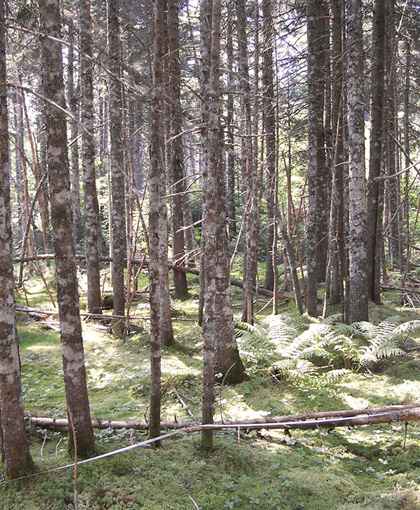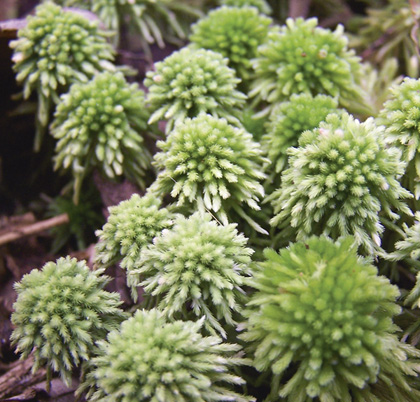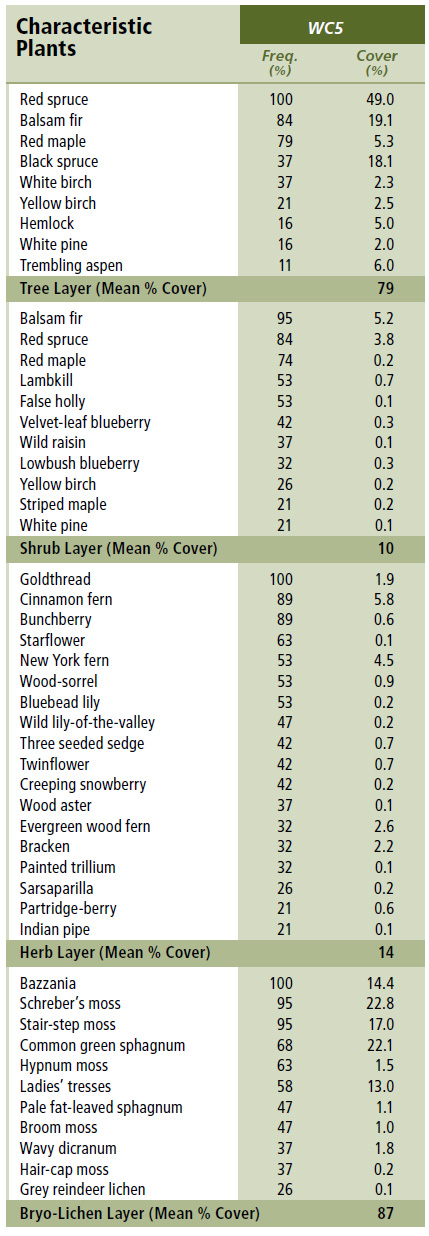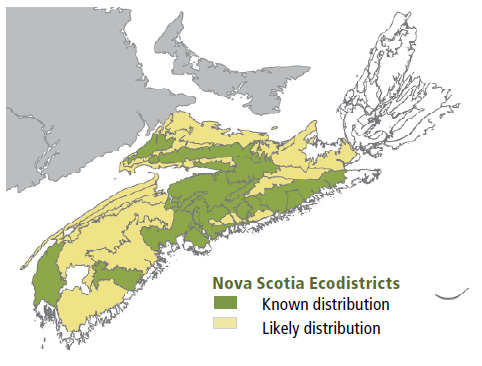
Forest Vegetation types - WC5
WC5 —Red spruce – Balsam fir/ Cinnamon fern / Sphagnum
Picea rubens – Abies balsamea / Osmunda cinnamomea / Sphagnum spp.
 |
Castlereagh, Colchester County |
Concept: This mature coniferous ecosystem is one of two wet red spruce forests found in Nova Scotia. WD8 is a comparable Vegetation Type (VT) with low to moderate levels of both red spruce and red maple. Red spruce – Balsam fir/ Cinnamon fern / Sphagnum forest is found on soils with reduced rooting potential and relatively low nutrient availability, but sites are generally more productive than those supporting wet black spruce forests (e.g. WC1 and WC2). It is a low-elevation ecosystem characterized by red spruce dominance and high sphagnum moss cover.
Vegetation: The evergreen canopy is dominated by red spruce with lesser but frequent balsam fir. Few other tree species are frequent in the canopy, but it is well developed with moderate to high crown closure. Woody shrub and herbaceous cover is low to moderate. Forest plants common to wet forest (e.g. cinnamon fern) are present, but few species are prominent. Sphagnum mosses largely dominate the dense bryophyte layer. Similar to other moderately-productive, wet coniferous VTs (i.e. WC6, WC7 and WC8), common green sphagnum is characteristic.
Environmental Setting: The Red spruce - Balsam fir/ Cinnamon fern / Sphagnum forest is found on lowland plains and gently rolling uplands. It is common on moderately exposed flats, depressions and in lower and toe positions of gentle slopes; aspect of the slope is variable. Soils are usually derived from fine to moderately textured glacial tills with low to moderate nutrient availability. Peat accumulation can be high, and while some stands grow on organic soil, most are on gleyed or heavily mottled mineral deposits. Sites are slightly to moderately mounded and generally have more microtopography than other wet coniferous forests in Nova Scotia. The VT is found throughout Nova Scotia, but is more common in the Eastern and Western ecoregions of the mainland. WC5 is relatively widespread and common in New Brunswick but rare on Prince Edward Island.
Successional Dynamics: This mid to late successional ecosystem is a type of edaphic climax, renewed by tree senescence, windthrow and other small to intermediate scaled disturbance agents. Between such disturbances, natural senescence can shape age class, favoring uneven stand structures. Windthrow and harvesting are the main stand-level disturbance agents. The mature forest may succeed from WC6 (Balsam fir / Cinnamon fern - Three seeded sedge / Sphagnum), WD6 (Red maple – Balsam fir / Wood aster / Sphagnum) or WD8 (Red spruce – Red maple / Wood sorrel – Sensitive fern / Sphagnum). Depending on disturbance history and nearby stand composition, WC5 may transition to WC8 (Hemlock / Cinnamon fern – Sensitive fern / Sphagnum).
Ecological Features:This relatively common ecosystem occurs as a small patch in larger upland matrix forests, at the edge of open wetlands, or adjacent to other wet forest types. It is a temperate wet forest, characterized by high canopy development, low woody understory cover and high bryophyte cover; herbaceous development is variable. Sites are somewhat acidic with only moderate microhabitat variability and species richness. Wet red spruce forests are generally found on more productive sites than similar wet black spruce forests, but few rare plants are documented. Old growth potential is low to moderate but may be higher in areas less prone to patch and stand-replacing disturbance. This well-developed wet forest may provide cover for moose and deer and locally important habitat features for numerous other forest wildlife. Similar to other wet forests, WC5 can regulate water flow, provide filtration, and recharge groundwater that are distinct from upland ecosystems.
 |
| Brittle stem sphagnum |
Distinguishing Features: Red spruce dominates this poorly drained softwood forest with some balsam fir. Sphagnum mosses, particularly common green and ladies' tresses dominate the groundcover. Both the shrub and herb layer are not well developed.
| Slope Position: | Level6 Toe2 Lower1 Depression1 |
Surface Stoniness: |
(Non - Slightly)8 (Moderately)1 (Very - Excessively)1 |
Bedrock Outcrop: |
(Non-rocky)10 |
Elevation Range: |
13 - 287m |
Slope Gradient: |
Level7 Gentle3 |
Aspect: |
North1 East2 South1 West1 None5 |
Exposure: |
Moderate5 Mod. exposed2 Mod. sheltered2 Sheltered1 |
Microtopography: |
Slightly5 Level2 Moderately2 Strongly1 |
Drainage: |
Poor7 Very poor2 Imperfect1 |
Soil Type: |
ST45 ST74 ST141 |
Parent Material: |
Glacial till7 Glaciofluvial1 Lacustrine1 Organic1 |
Rooting Depth (cm): |
(<30)8 (30-45)1 nd1 |
Duff Thickness (cm): |
(6-10)1 (11-20)4 (21-40)4 nd1 |

